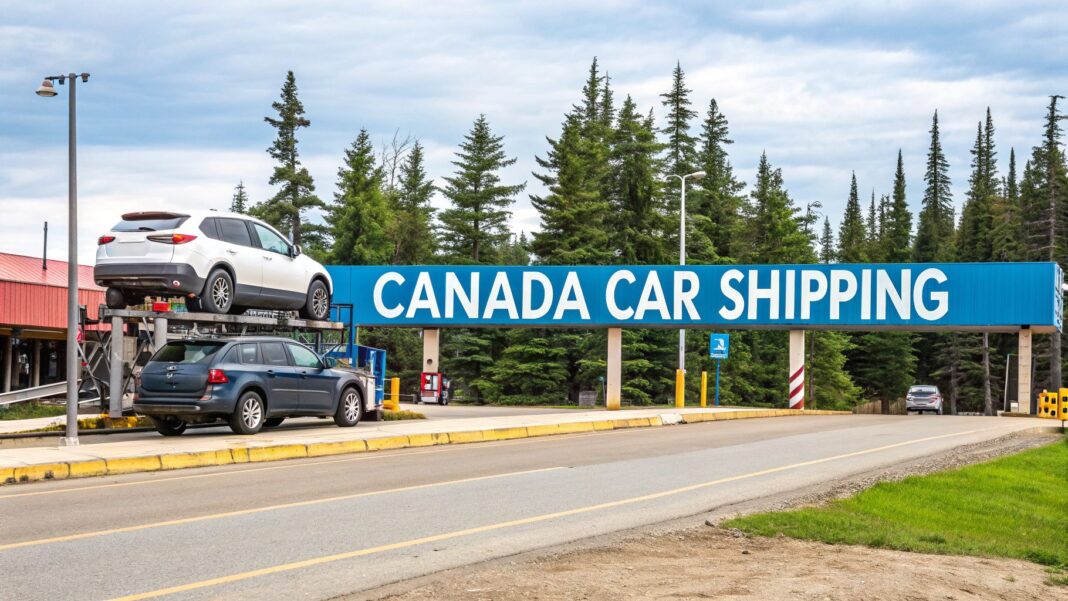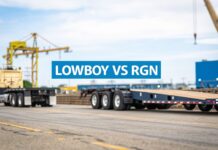
Shipping a car from Canada, especially to the U.S., involves more than just booking a truck. It’s a multi-step process requiring a clear understanding of documentation, transport options, and customs procedures. The entire process can be broken down into four critical stages: document preparation, choosing your transport method, clearing customs, and calculating the final cost.
This guide provides the actionable steps you need to manage the process efficiently.
Your Roadmap to Shipping Cars from Canada
Moving a vehicle across the border can seem complex, but it becomes manageable when broken down into clear, actionable steps. Whether you're sending a daily driver from Toronto to Miami or a classic car to a new home, the key to a seamless experience is preparation. This starts with gathering all the essential paperwork before you contact a carrier.

This guide is designed to provide a clear, step-by-step framework, giving you the confidence to ship your vehicle without encountering costly, last-minute surprises.
The U.S.-Canada automotive trade is a well-established corridor. In 2023, Canada exported cars valued at approximately $37.4 billion, with the U.S. being the destination for $35 billion of that total. This high volume means transport logistics are streamlined and efficient. For a deeper look at these figures, you can explore the global trade dynamics on OEC.world.
What to Expect in This Guide
To ensure you're fully prepared, we will cover the most critical aspects of the shipping process. Each section provides practical information you can use immediately.
- Essential Documents: A detailed checklist of the non-negotiable paperwork required for export, including the Certificate of Title and Bill of Sale, to ensure a smooth border crossing.
- Transport Methods: A practical comparison of your primary shipping options—open vs. enclosed carriers—to help you balance cost, security, and timing based on your vehicle's specific needs.
- Customs and Border Clearance: A clear guide to navigating Canadian export and U.S. import procedures, including required forms and potential duties, to avoid customs holds.
A successful vehicle shipment hinges on meticulous preparation. Overlooking a single document or choosing an inappropriate transport method for a valuable car can lead to significant delays and unexpected costs at the border.
By addressing these core areas, you can avoid common pitfalls. The following sections provide actionable checklists and practical examples to guide you through each stage of the process.
Mastering Your Essential Shipping Documents
When shipping cars from Canada, accurate and complete paperwork is the most critical factor for avoiding delays at the border. A single missing document or incorrect form can halt the entire process, leaving your car in administrative limbo.
Treat your paperwork as the vehicle's passport; without it, the shipment will not proceed. Allocating extra time to ensure every document is in order is the best way to prevent future complications.
The Core Documents for Export
Before your vehicle is scheduled for pickup, you must have the following documents ready for your transport company and customs authorities. Do not initiate the shipping process until these are in your possession.
- Original Certificate of Title: You must provide the original title, not a copy. It must be clean, with no active liens. If a lien exists, you need an original, notarized letter from the lienholder explicitly authorizing the vehicle's permanent export.
- Bill of Sale: For recently purchased vehicles, a dated Bill of Sale is required. It must clearly list the seller, buyer, purchase price, and the Vehicle Identification Number (VIN) as proof of ownership transfer.
- Valid Government-Issued ID: A clear copy of your driver's license or passport is needed for identity verification. Ensure it is not expired to prevent unnecessary delays.
From experience, the most frequent issue delaying shipments is a problem with the Certificate of Title. Whether it's a lost original, an undisclosed lien, or an incomplete transfer, title-related problems are the primary reason vehicles are held at the Canadian border.
The 72-Hour Rule and Your AES Filing
Customs procedures operate on a strict timeline. Both Canadian and U.S. authorities require all export documentation to be submitted for review well before the vehicle reaches the border.
Specifically, your export documents must be sent to the Canadian Border Services Agency (CBSA) at least 72 hours before the scheduled border crossing. This is a non-negotiable deadline. Your shipping company will typically manage the electronic filing through the Automated Export System (AES), which officially declares the shipment to U.S. Customs and Border Protection (CBP).
This 72-hour window allows agencies to verify the paperwork and ensure the export is legitimate, making it a critical step you cannot bypass.
What About Leased and Financed Vehicles?
Shipping a vehicle with an active loan or lease requires an additional but crucial step: obtaining written permission from the financial institution holding the title.
You will need an original, notarized letter from the lienholder. This document must explicitly state that they authorize the permanent export of the vehicle. Without this specific language, customs will reject the shipment.
While reputable transport companies are familiar with this requirement, obtaining the letter is your responsibility. Selecting a carrier that can guide you through this process is vital. For more insights on choosing a provider, read our guide on how to find a good car shipping service.
Choosing The Right Way To Ship Your Car
Selecting a transport method is a strategic decision that directly affects your budget, timeline, and the safety of your vehicle. A careful evaluation of your options is necessary to align the service with your specific needs.
The two primary ground transport methods are open carrier and enclosed carrier. Understanding the practical differences between them is the first step to making an informed choice.
Open vs. Enclosed Transport: What's The Real Difference?
The majority of vehicles are shipped via open carrier transport. It is the most common and cost-effective method for moving a car. These are the large, multi-level haulers frequently seen on highways and are a practical choice for shipping a standard sedan, SUV, or truck from Calgary to Arizona.
The trade-off is exposure to the elements. Your car will be open to rain, sun, road dust, and debris. While significant damage is rare, it is a risk to consider in exchange for the lower cost.

For a higher level of protection, enclosed carrier transport is the premium option. Your vehicle is transported inside a fully sealed trailer, shielding it from weather, road hazards, and public view. This is the recommended choice for shipping classic, luxury, or high-value vehicles, where the added cost provides essential security.
The decision comes down to your vehicle's value and your risk tolerance. For a standard daily driver, an open carrier is usually sufficient. For any car with significant monetary or sentimental value, an enclosed carrier is the prudent investment.
Going Overseas? RoRo vs. Container Shipping
For international shipments across an ocean, your choices are Roll-on/Roll-off (RoRo) and container shipping.
- RoRo Shipping: This method treats the transport vessel like a large, floating parking structure. Your vehicle is driven onto the ship and secured. It is the more economical option but offers less security, as the vehicle is accessible to the crew.
- Container Shipping: Your vehicle is loaded into a sealed steel container, either by itself or with other cars. This provides superior protection from weather and potential theft but comes at a higher cost.
To simplify your decision, this table provides a direct comparison of the most common transport methods.
Comparing Car Transport Options from Canada
| Transport Method | Best For | Average Cost | Protection Level | Typical Transit Time |
|---|---|---|---|---|
| Open Carrier | Standard vehicles, daily drivers, budget-conscious shippers | $ | Low-Moderate | 5-14 days (North America) |
| Enclosed Carrier | Luxury, classic, exotic, or high-value cars | $$$ | High | 5-14 days (North America) |
| RoRo Shipping | Standard vehicles for overseas transport, budget-friendly | $$ | Low | 2-6 weeks (Overseas) |
| Container Shipping | High-value cars, shipping personal items, maximum security | $$$$ | Very High | 3-7 weeks (Overseas) |
Ultimately, the optimal choice depends on your vehicle's value, your budget, and your required delivery timeframe.
Making Your Final Call
The high volume of vehicle trade between Canada and the U.S. ensures competitive pricing and frequent carrier availability. For instance, in early 2024, Canadian motor vehicle exports to the U.S. reached approximately US$7.66 billion, highlighting the constant movement of vehicles across the border.
This robust market means you will have numerous options, especially on major shipping routes. Always request quotes for both open and enclosed transport; the price difference may be less than you expect.
For a comprehensive overview of the entire shipping journey, our guide explaining how car shipping works in detail provides valuable insight into the logistics of moving your vehicle safely.
Navigating Customs and Border Requirements
https://www.youtube.com/embed/hZzHGtL2RwQ
Successfully navigating the border is where your preparation pays off. The process involves two distinct stages: clearing Canadian export control with the Canadian Border Services Agency (CBSA) and then clearing U.S. import control with U.S. Customs and Border Protection (CBP). You must satisfy the requirements of both agencies.
Should You Hire a Customs Broker?
A customs broker is a licensed professional who specializes in navigating international trade regulations. They manage paperwork, communicate with government agencies, and ensure compliance on your behalf. While it is possible to handle this yourself, hiring a broker is a worthwhile investment for most individuals.
Brokers are experts in tariff codes, duty calculations, and proper filing procedures, which helps prevent costly errors. Their fee often pays for itself by avoiding delays and ensuring a smooth clearance process.
The Must-Have U.S. Import Forms
Upon arrival at the U.S. border, CBP requires specific forms to verify the vehicle complies with American standards. These documents are mandatory and must be completed accurately.
- EPA Form 3520-1: This Environmental Protection Agency form declares that the vehicle meets U.S. emissions standards. Most Canadian-market vehicles are manufactured to specifications similar or identical to their U.S. counterparts, making this a straightforward declaration.
- DOT Form HS-7: This Department of Transportation form confirms the vehicle meets U.S. Federal Motor Vehicle Safety Standards (FMVSS). You will check the box corresponding to your vehicle's manufacturing specifications.
Pro Tip: Before filling out any forms, locate the manufacturer's certification label inside the driver's side door jamb. This sticker will state whether the vehicle conforms to U.S. safety and emissions standards. If this label is missing or contradicts your paperwork, it will be a significant red flag for customs officials.
What About Duties and Taxes?
The cost of duties and taxes depends on the vehicle's country of origin and your residency status.
If you are a U.S. resident returning with a vehicle you previously used in Canada, you typically will not owe duty. However, if you are importing a foreign-manufactured car purchased in Canada, you should expect to pay a duty, which is generally 2.5% of the vehicle's declared value.
The scale of U.S.-Canada auto trade is immense. In March 2024 alone, Canada's exports of cars and light trucks were valued at approximately CAD $5.024 billion. You can discover more about these import and export dynamics to understand the volume. Familiarity with a general business compliance checklist can also provide a useful overview of international regulatory practices.
The Collector's Lifeline: The 25-Year Rule
A significant exemption exists for classic car enthusiasts. If a vehicle is at least 25 years old, it is generally exempt from meeting modern EPA and DOT safety and emissions standards.
This rule is a game-changer for importing vintage and classic vehicles. While you still must file all required paperwork, you can declare the vehicle exempt on the forms based on its age. This allows collectors to import unique and historic automobiles into the U.S. without facing insurmountable compliance challenges.
How to Prepare Your Vehicle for Transport
Properly preparing your car is a critical step to protect your investment, prevent delays, and ensure a smooth handover. This is not just a quick clean-up; it is a vital part of the transport process that safeguards against damage.
The first and most important preparation task is managing the fuel level. The gas tank must be no more than one-quarter full. This is a mandatory safety requirement to reduce the vehicle's weight and minimize fire risk during transit. Arriving with a full tank will likely result in your shipment being delayed until the excess fuel is removed.

Documenting Your Vehicle's Condition
Before the carrier arrives, you must meticulously document your car's pre-shipment condition. This record serves as your primary evidence in the event of a damage claim.
Start by washing the vehicle thoroughly to make any imperfections visible. Then, use your smartphone to take high-resolution photos and videos from every angle—front, back, sides, roof, and hood. Zoom in on any existing scratches, dents, or dings. Document the interior, the odometer reading, and, if possible, the undercarriage.
A timestamped video walkthrough is the most effective way to create a record. Narrate the video, pointing out specific details as you record. This creates an undeniable document that can quickly resolve any potential disputes.
A structured approach, such as creating a flawless vehicle inspection report before pickup, is the best way to prove the vehicle's condition.
Cleaning and Mechanical Checks
A strict rule in auto transport is to remove all personal belongings. Carriers are not licensed to transport household goods, and their insurance does not cover personal items. This includes everything in the trunk, glove compartment, and cabin. The only items that should remain are factory essentials, such as a spare tire and a jack.
Finally, perform a quick mechanical check to ensure the vehicle is ready for loading and unloading.
- Check for Leaks: Repair any significant fluid leaks before pickup. Carriers can refuse a vehicle that may drip fluids and damage other cars on the trailer.
- Secure the Battery: Ensure the battery is secure in its mounting bracket and fully charged.
- Tire Pressure: Inflate all tires to the manufacturer's recommended PSI to facilitate easy loading.
- Alarms: Disable any aftermarket alarms to prevent them from activating during transit, which can drain the battery and cause a disturbance.
These preparatory steps are essential. They not only protect your vehicle but also help you avoid penalties and delays that can impact the final cost to ship a car.
Your Top Questions About Shipping a Car from Canada, Answered
Even with a detailed plan, practical questions often arise. Addressing these final details will ensure you are fully confident in the shipping process. Here are answers to the most common questions we receive.
So, How Much Does It Really Cost to Ship a Car from Canada to the US?
The final cost is influenced by several factors: total distance, transport method (open vs. enclosed), vehicle size and weight, and the time of year.
As a general estimate, shipping a standard sedan from Toronto to New York via an open carrier typically costs between $800 and $1,200 USD. A longer route, such as Vancouver to California, would likely range from $1,500 to $2,200 USD. Choosing an enclosed carrier for added protection will increase the cost by approximately 40-60%. Remember to also budget for potential customs broker fees.
How Long Will I Be Without My Car?
Transit time includes pickup, transport, border crossing, and final delivery. A shipment from Montreal to Miami, for example, usually takes 10 to 14 days. A cross-continental move from British Columbia to Florida could take up to 21 days.
Pro Tip: The border crossing itself can add one to three days to the total transit time, depending on customs volume and the accuracy of your paperwork. Build this potential delay into your timeline.
Can I Stuff My Car with Personal Belongings to Save Space?
The answer is a definitive no. Auto transport companies are licensed only to move vehicles, and their insurance does not cover personal items left inside.
Furthermore, both U.S. and Canadian customs require the vehicle to be empty for inspection. Attempting to ship personal goods inside your car can lead to significant delays, fines, or even rejection of the entire shipment at the border. It is essential to remove everything except for factory-standard equipment like a spare tire and jack.
What’s the Deal with Insurance During Transport?
All legitimate auto transport companies are required by law to carry cargo insurance, which covers your vehicle against damage during transit. Before finalizing your booking, always request a copy of their certificate of insurance to verify coverage details and limits.
It is also advisable to contact your personal auto insurance provider, as your policy may offer some coverage while the vehicle is being transported. For high-value, classic, or exotic cars, purchasing supplemental insurance is a recommended step for complete peace of mind.
When you're ready to get your car moving, We Will Transport It has the expertise to manage the entire process smoothly. Get your free, no-obligation quote and see how we can help at https://www.wewilltransportit.com.





